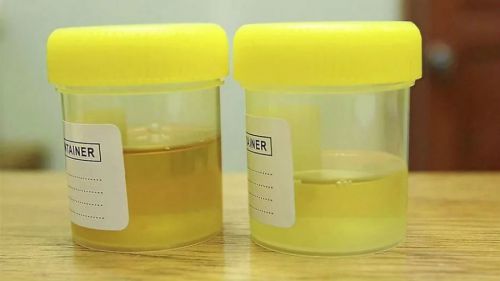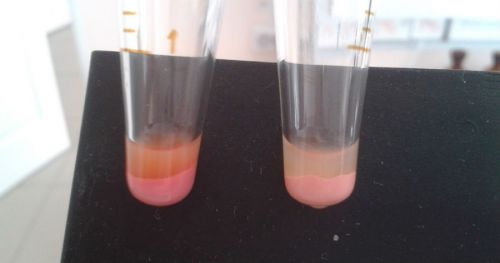White sediment in urine
In a healthy person, urine has a light yellow or yellow color, transparent without the presence of sediment or any impurities. Cloudy urine can be a serious reason to fear for your health. Why does a sediment appear in the urine and what does its presence mean? This can happen for a number of reasons. For example, in the absence of clinical symptoms, the appearance of turbidity may be the result of a lack of fluid in the body. If this happens after waking up, then a sediment in the urine may indicate the presence of salts.
There are also situations when the causes of the sediment are not associated with the presence of any pathological process and the person does not need medical assistance, the following situations can be attributed to the same situations:
- intense physical activity;
- hot climate;
- visiting a bath or sauna.
The diagnosis should be made by a specialist, and not by the person himself, on the basis of a diagnostic study. The examination will help to exclude or confirm the presence of diseases of the urinary system.
Factors that lead to the appearance of sediment
The following factors can contribute to the appearance of an unorganized urine sediment:
- imbalance of salt and fluid. This reason is one of the most common. Due to the fact that an insufficient amount of fluid enters the body, the percentage of salts increases. The resulting solid deposits simply impede the full outflow of urine. As a result, congestion develops, urine becomes cloudy and this can provoke the appearance of an inflammatory process;
- the presence of mucus, bacteria, flakes can affect the clarity of urine. If turbidity appears, but the color does not change, then this may indicate the development of cystitis (inflammation of the bladder), urethritis, or even pyelonephritis. The appearance of a precipitate in the form of a cloud may indicate lung diseases;
- the movement of solid salt deposits can provoke trauma to the mucous membrane of the urinary tract. In addition to the appearance of sediment, the shade of urine will also change, up to red.
White sediment in urine
White sediment in the urine may appear even without the presence of pain. But even in this case, such a picture may indicate a problem in the genitourinary system. If the appearance of a white precipitate is accompanied by the detection of protein in the urine, then this is a clear sign of a developing inflammatory process. Immediately I would like to note that it is necessary to deliver urine for research as early as possible. The fact is that if a sample of biological material is placed in a container with a tightly closed lid for some time, then the appearance of turbidity as a result of the decomposition of salts is a natural process and a state of the norm.

A general urine test will give an accurate answer about the causes of the precipitation.
It is worth noting the fact that in some cases, incorrect collection of a sample for research can provoke the appearance of a precipitate. In order to avoid this, you should follow simple recommendations, namely:
- on the eve of the study, you should not eat foods that could lead to urine staining, these are beets, rhubarb, carrots, etc .;
- do not take preparations containing iron, most often these are vitamin-mineral complexes;
- before collecting urine, you need to wash yourself, but you should not use thick and poorly washed off cosmetics, gels, foams. If hygiene procedures are not carried out, then elements from the vagina may appear in the urine of women.
In addition, the true reasons that sediment precipitates in the urine are insufficiently clean containers. Even if the jar is thoroughly washed, there may be substances in it that will react with urine and lead to sediment. It is for this reason that it is better to use sterile bottles that are sold in pharmacies.
Some patients make the mistake of collecting urine in the evening, putting it in the refrigerator, and taking it to the laboratory in the morning. During this time, bacterial microorganisms can develop in urine. Also, as a result of the fact that the biological material stood in the cold, a precipitate may appear.
The appearance of a white precipitate may be due to an increased level of white blood cells, red blood cells, or salts in the urine. Microscopic analysis will help to give an accurate answer about the number of organized elements. First, the laboratory assistant unscrews the test tube with urine in a centrifuge, drains the urine, and deposits a precipitate on a glass slide. Under a microscope, the number of different elements will be clearly visible. For example, turbidity can also cause inorganic sediment, such as uric acid crystals, which, when elevated, can lead to diseases such as gout.

Urine stored in the evening is not suitable for research
Non-pathological causes
Before panicking and attributing to yourself the presence of serious diseases, the first thing to do is to exclude the natural causes of cloudiness. Immediately you need to think about the amount of water consumed, as well as the diet. This situation can occur in vegetarians, as well as people who have rapidly changed their diet and, for example, switched to protein foods.
Changes in the composition of urine depending on age and gender
If we talk about women, then they have a change in the composition of urine can provoke such reasons:
- violation of the natural microflora of the vagina;
- vaginal discharge;
- lowering of the mucous plug during pregnancy.
If a woman has vaginal candidiasis, which is accompanied by the appearance of copious cheesy discharge, then they can easily get into the urine and fall out as a white precipitate.
In men, a change in the composition of urine may indicate the presence of developing urethritis or balanopastitis. Urethritis may be the result of hypothermia or a viral infection. In addition to the appearance of sediment, patients may complain of pain in the groin and lower abdomen, discomfort may increase with urination or ejaculation.
If we talk about balanopastitis, then most often it does not occur as a primary disease, but against the background of infectious processes that are sexually transmitted. The pathological process is accompanied by the appearance of the following symptoms: inflammation of the foreskin, irritation of the penile mucosa and increased secretion of smegma.
Both diseases can also cause severe pain and burning during urination, purulent discharge, as well as cloudy urine and sediment. Turbidity can also be the result of prostatitis or sexually transmitted diseases.
Separately, I want to say about the children. The appearance of a white sediment in the urine of a baby should not be a cause for concern for parents. This is due to the physiological characteristics of the newborn and the adaptation of the body to new living conditions.

The appearance of an orange precipitate may indicate the presence of amorphous urates.
Causes of orange urine
The reasons that the urine has acquired an orange color may be as follows:
- increased levels of urochrome or urine pigments;
- disorders of the urinary system;
- dehydration of the body, especially in hot weather with intensive work and a small amount of fluid consumed;
- taking certain medications: laxatives, anti-tuberculosis. antitumor;
- foods such as raspberries, blackberries, pumpkins, carrots, etc. can color urine;
- orange urine in the morning can be caused by hormones. Antidiuretic hormone can color urine;
- the presence of food dyes in food (lemonade, juices, sweets).
So, sediment can appear in the urine for both natural and pathological reasons. You should not immediately worry, but the first thing you need to remember is what foods you took the day before, what medications you take. If the appearance of the precipitate is of a short-term nature and is not accompanied by the appearance of other symptoms, then most likely there is no cause for concern. If you have pain in the lower abdomen, painful urination, burning or other symptoms, then it is best to consult a specialist, because this may be a sign of serious inflammatory processes in the urinary system. Early diagnosis and a qualified approach will help to quickly fix the problem!




